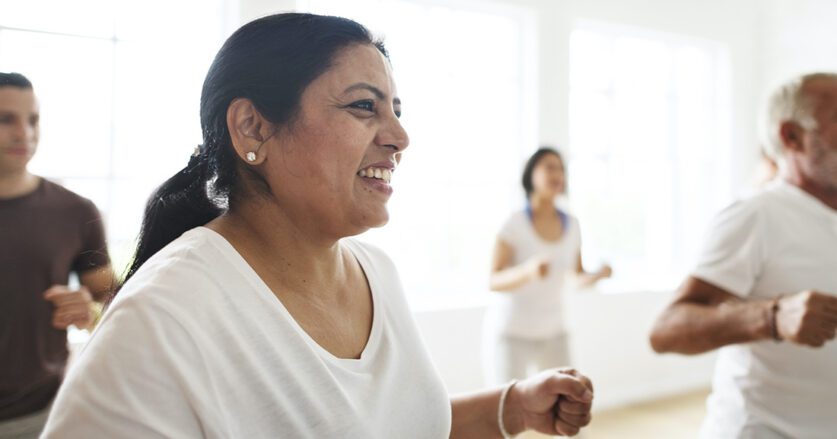Call Us Now1-800-414-2174


By F. Perry Wilson, MD, MSCE, Yale School of Medicine
One hundred and fifty minutes (2 ½ hours) a week. That’s the minimum recommended amount of moderate-intensity exercise that the federal government advises the American people to do to optimize their health.
One hundred and fifty minutes a week also translates into 30 minutes per day, 5 days per week. That number wasn’t pulled out of thin air. There is considerable observational data that shows that people who are more physically active have better health outcomes. Those who hit that 150 minutes–a-week mark have around a 30% reduction in overall mortality rates, even when you control for health status at baseline.
But only about half of Americans actually get that much exercise with younger people doing better than older people, and men getting a bit more exercise than women.
How do you get more people to exercise? Maybe you need to make it easier.
Part of the reason that a lot of people miss the target is that 150 minutes just seems daunting. The physical activity guidelines suggest that these 150 minutes be “spread throughout the week.” But not all of us have 30 minutes a day, Monday through Friday, to take a brisk walk on a treadmill or a jog around the block.
Could it be good enough to hit the weekly target all at once?
The agreed-upon scientific term for this behavior — doing all your weekly exercise in one or two big sessions — is the “weekend warrior” pattern. A large study published in JAMA Internal Medicine 1 asks whether weekend warriors are as protected from death as people who spread their exercise more evenly.
In the JAMA Internal Medicine study, compared with those who exercise regularly throughout the week, weekend warriors were younger, more likely to be male, have a lower level of education and a lower overall income level. Overall, the researchers found that, compared with people who do not hit those 150 minutes a week of physical activity, those who do are significantly less likely to die — about 15% less likely. They had 23% less cardiovascular disease and 12% less cancer as well. The duration of each exercise session seemed to be relatively important. The mortality benefit was seen in people who exercised more than 20 minutes at a time.
So, would those weekend warriors — cramming all their 150 minutes into 1 or 2 days — fare the best of all? Not really. The authors compared the weekend warriors with the regularly active and found no statistical difference in mortality rates.
Now, these studies are not as simple as they might seem at first blush. Individuals who are sick with chronic disease may exercise less because of that disease, and also be more likely to die because of that disease. That would make exercise appear protective, when in reality the ability to exercise is just a marker of general good health.
To avoid this reverse causation, the authors excluded individuals who had been diagnosed with cancer, bronchitis, COPD, or stroke at baseline. What’s more, they excluded deaths that occurred within 2 years of the survey being taken, on the idea that maybe an undiagnosed disease was already present and limiting exercise ability. This is smart epidemiology.
Of course, many things impact your ability to exercise and might make you live longer. A big one? Money. It is no secret that, in the US at least, having a high income is associated with better health outcomes. High earners may also be able to afford that gym membership or the babysitter to watch the kids while they get some exercise.
To address this confounder, and others that might spuriously link exercise and death, the results were adjusted for income, age, sex, race, ethnicity, marital status, educational attainment, smoking, alcohol intake, other comorbidities, mobility, and self-rated health.
But statistical adjustment is a double-edged sword. While we want to adjust for things, like income, that are related to our exposure (exercise) and outcome (death), we do not want to adjust for things that lie along the causal pathway from exposure to outcome.
Take body mass index, for example. At first blush, you might think we should adjust for BMI when evaluating the link between exercise and death. People with higher BMI may be able to exercise less and, in general, have worse health outcomes. But exercise may reduce BMI. In fact, one of the reasons exercise might be beneficial is because it reduces BMI. Also, exercise may actually decrease smoking rates, and alcohol intake? If so, these might be on that causal pathway from exercise to survival.
So, we need to look at that final estimate of benefit — 15% reduction in mortality — with a bit of a skeptical eye. The true number could be quite a bit higher. It could probably be lower too.
Of course, physical activity, as a medical intervention, has just about the best risk:benefit ratio you could imagine. The message of this paper, underneath all the epidemiology and statistics, is a simple one: Get some exercise, whenever you can. It’s good for you.
References:
Dr. Wilson is an associate professor of medicine and director of Yale’s Clinical and Translational Research Accelerator. His science communication work can be found in the Huffington Post, on NPR, and on Medscape. He tweets @fperrywilson and hosts a repository of his communication work at www.methodsman.com.
Note:
WorkSaver provides highly motivational live seminars and webinars on injury prevention, ergonomics, and wellness for employees. Also, certification in behavioral-based ergonomics is offered by experienced ergonomic specialists. The program (CBES) description and registration information are provided at www.cbes-ergonomcs.com.
WorkSaver System also has 30 years of experience providing EEOC-compliant physical abilities tests (PATs) nation-wide to help ensure employees are fit for duty.
Interested? Call WorkSaver Systems at (985) 853-2214 or e-mail Trevor Bardarson, CEO, at trevor@worksaversystems.com
WorkSaver Employee Testing Systems 478 Corporate Dr. Houma, LA 70360
![]()